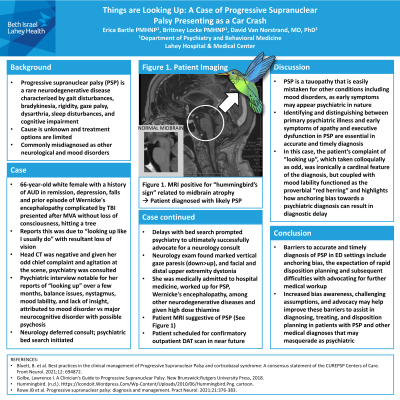Neurocognitive Disorders and Neuropsychiatry
(103) Things are Looking Up: A Case of Progressive Supranuclear Palsy Presenting as a Car Crash


Erica Bartle, MSN, PMHNP (she/her/hers)
Psychiatric Nurse Practitioner Fellow
Beth Israel Lahey Medical Center
Burlington, Massachusetts
Brittney Locke, MSN, PMHNP-BC
Nurse Practitioner
Lahey Hospital & Medical Center
Burlington, Massachusetts
David Van Norstrand, MD,PhD
Director of Consult Psychiatry
Beth Israel Lahey Health (Lahey Hospital)
Somerville, Massachusetts
Presenting Author(s)
Co-Author(s)
Background:
Progressive supranuclear palsy (PSP) is a rare neurodegenerative disease starting around age 65 with a prognosis of 7 years and prevalence at about 5 in 100,000 (Globe, 2018). PSP is characterized by gait disturbances, bradykinesia, rigidity, gaze palsy, dysarthria, sleep disturbances, and cognitive impairment, with the cause of PSP unknown and treatment options limited (Bluett, 2021). It is commonly misdiagnosed as other neurological and mood disorders, often presenting the psychiatric consultant with significant diagnostic challenges (Rowe, 2021). We present a case that highlights the diagnostic complexity in an emergency setting.
Case:
A 66-year-old white female with a history of alcohol use disorder in remission, depression, falls and prior episode of Wernicke's encephalopathy complicated by TBI who presented after a car accident without loss of consciousness. She reported hitting a tree because she “was looking up like I usually do” and could not see. Head CT was negative and given her odd chief complaint and agitation at the scene, psychiatry was consulted. Psychiatric interview was notable for her reports of “looking up” episodes over a few months, balance issues, nystagmus, mood lability, and lack of insight, attributed to mood disorder versus major neurocognitive disorder with possible psychosis, and a psychiatric bed search was initiated. Given delays with bed search, psychiatry ultimately successfully requested a neurology consult (earlier requests were declined). Neurology exam was notable for marked vertical gaze paresis (down >up), and facial and distal upper extremity dystonia. She was medically admitted to hospital medicine, worked up for PSP, Wernicke's encephalopathy, among other neurodegenerative diseases and given high dose thiamine. MRI positive for “hummingbird’s sign” related to midbrain atrophy, suggesting likely PSP. At the time of this submission, patient remains in the hospital awaiting discharge and outpatient DAT scan.
Discussion:
PSP is a tauopathy that is easily mistaken for other conditions including mood disorders, as early symptoms may appear psychiatric in nature (Rowe, 2021). Identifying and distinguishing between primary psychiatric illness and early symptoms of apathy and executive dysfunction in PSP are essential in accurate and timely diagnosis. In this case, the patient’s presenting complaint of “looking up”, which taken colloquially as odd, was ironically a cardinal feature of the diagnosis, but coupled with mood lability functioned as the proverbial “red herring” and highlights how anchoring bias towards a psychiatric diagnosis resulted in diagnostic delay.
Conclusion:
Barriers to accurate and timely diagnosis of progressive supranuclear palsy in ED settings include anchoring bias, the expectation of rapid disposition planning and subsequent difficulties with advocating for further medical workup. Increased bias awareness, challenging assumptions, and advocacy may help improve these barriers to assist in diagnosing, treating, and disposition planning in patients with PSP.
References:
Bluett, B. et al. Best practices in the clinical management of Progressive Supranuclear Palsy and corticobasal syndrome: A consensus statement of the CUREPSP Centers of Care. Front Neurol. 2021;12: 694872.
Golbe, Lawrence I. A Clinician's Guide to Progressive Supranuclear Palsy. New Brunswick:Rutgers University Press, 2018.
Rowe JB et al. Progressive supranuclear palsy: diagnosis and management. Pract Neurol. 2021;21:376-383.
Presentation Eligibility: Not previously published or presented
Diversity, Equity, and Inclusion: This submission brings awareness of provider bias and barriers to quality care and accurate and timely diagnosis of neurological diseases for patients' who present with psychiatric histories or what at first glance appear to be primarily psychiatric symptoms. Reflecting on our own assumptions and working towards holistic and thorough approaches will lead to better patient outcomes for marginalized psychiatric populations.

